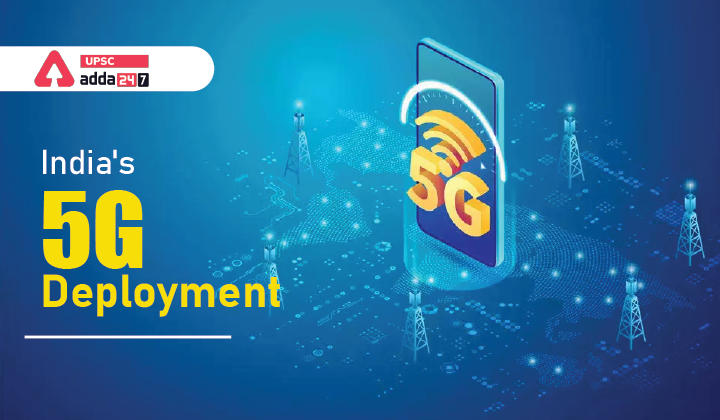Table of Contents
With over 117 crore telecom users and more than 82 crore internet subscribers, India is one of the fastest-growing markets for digital consumers, India is one of the fastest-growing markets for digital consumers.
India is the second-fastest digitizing economy according to a 2019 study by Mckinsey
5G Technology is going to make inroads into the country very soon. A basic requirement of 5G will be data transmission networks. Optical fibre is the backbone of the digital infrastructure required for this purpose — the data is transmitted by light pulses travelling through long strands of thin fibre.
WHAT IS 5G TECHNOLOGY AND HOW IT IS DIFFERENT?
- 5G or fifth generation is the latest upgrade in the long-term evolution (LTE) mobile broadband networks and works in 3 bands, namely low, mid and high frequency spectrum.
- Low band spectrum has shown great promise in terms of coverage and speed of Internet and data exchange, the maximum speed is limited to 100 Mbps (Megabits per second) which makes it suitable for commercial cellphone users who may not have specific demands for very high-speed Internet, the low band spectrum may not be optimal for specialized needs of the industry.
- The mid-band spectrum, on the other hand, offers higher speeds compared to the low band, but has limitations in terms of coverage area and penetration of signals.
- 5G has indicated that this band may be used by industries and specialized factory units for building captive networks that can be moulded into the needs of that particular industry
- 5G offers the highest speed of all the three bands, but has extremely limited coverage and signal penetration strength.
EVOLUTION FROM FIRST GENERATION TO FIFTH GENERATION
- 1Gwas launched in the 1980s and worked on analog radio signals and supported only voice calls.
- 2Gwas launched in the 1990s which uses digital radio signals and supports both voice and data transmission with a bandwidth of 64 Kbps.
- 3Gwas launched in the 2000s with a speed of 1 Mbps to 2 Mbps and it has the ability to transmit telephone signals including digitised voice, video calls and conferencing.
- 4Gwas launched in 2009 with a peak speed of 100 Mbps to 1 Gbps and it also enables 3D virtual reality.

5G in INDIA
- India’s National Digital Communications Policy 2018 highlights the importance of 5G when it states that the convergence of a cluster of revolutionary technologies including 5G, the cloud, Internet of Things (IoT) and data analytics, along with a growing start-up community, promise to accelerate and deepen its digital engagement, opening up a new horizon of opportunities.
- India had, in 2018, planned to start 5G services as soon as possible, with an aim to capitalize on the better network speeds and strength that the technology promised and now government has decided to auction off 72 Ghz of airwaves to rollout 5G services in the country.
THE CHALLENEGES
Major challenge that India will face while enabling the 5G services in the country will be the process of FIBERISATION-Connecting radio towers with each other via OPTIAL FIBRE CABLE.
- FIBRE based media-OPTICAL MEDIA provides infinite bandwidth and coverage and, low latency and high insulation from interference. For better coverage to consumers and businesses, it will be necessary to increase the density of mobile towers.
- To fully utilize the 5G services we need to increase the fiberized towers (currently on 33%) and for that we need atleast 16 times more fibre.
- Data capacity needs to be increased as well in fiberized towers.
- Government programmes like BharatNet and Smart cities along with PM Narendra Modi’s vision to connect every village in the country with Optical Fibre Cable (OFC) in 1000 days needs to push the cable deployment speed to 1251 km a day from the existing one that stands at 350 km a day.
- The Indian Telegraph Right of Way rules, 2016 a gazette notified by Department of Technology to incorporate nominal one-time compensation and uniform procedure for establishment of Overground Telegraph Line (OTL) needs to be implemented uniformly throughout the country by states as well as various ministries that have yet not adopted these rues citing their own departmental rules.
STEPS TAKEN BY GOVERNMENT
- DoT’S GatiShakti- An online portal to simplify Right of Way (RoW) approvals and deployment of 5G cables.
- This will enable the centralization of approvals for telecom infrastructure projects including 5G and help the operators to deploy the required infrastructure for the upcoming 5G rollout in a timely manner.
- DoT has revised the RoW rules in 2021 making it easier to install aerial optical fibre cable in the country.



 TSPSC Group 1 Question Paper 2024, Downl...
TSPSC Group 1 Question Paper 2024, Downl...
 TSPSC Group 1 Answer key 2024 Out, Downl...
TSPSC Group 1 Answer key 2024 Out, Downl...
 UPSC Prelims 2024 Question Paper, Downlo...
UPSC Prelims 2024 Question Paper, Downlo...
